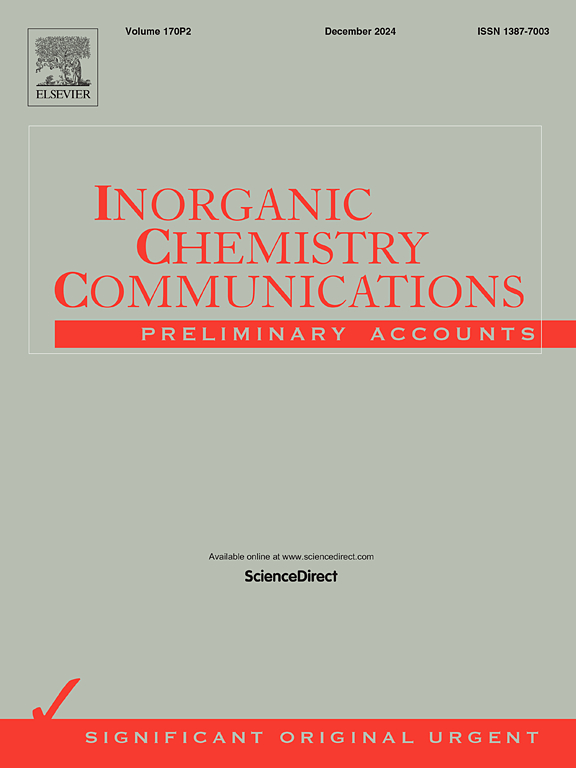Kelp-derived Cu-Fe3C@KC nanoclusters for microwave-assisted catalytic dye degradation
IF 4.4
3区 化学
Q1 CHEMISTRY, INORGANIC & NUCLEAR
引用次数: 0
Abstract
The rapid growth of the dyeing and printing industry has resulted in severe water pollution, posing significant threats to human health and ecosystems. To effectively tackle this challenge, this study presents a novel approach using marine biomass-derived carbon (kelp) combined with Prussian blue (FeCu-PBA) to synthesize carbon-based nanoclusters (Cu-Fe3C@KC) for efficient microwave-assisted degradation of high-concentration dyes. By optimizing the FeCu-PBA-to-kelp mass ratio (FeCu/KC), we tailored the material’s morphology and enhanced its microwave absorption properties, achieving rapid and effective dye degradation. Experimental results demonstrate that Cu-Fe3C@KC-3 degraded methyl orange, methylene blue, crystal violet, and rhodamine B with efficiencies of 99.37 %, 96.23 %, 94.67 %, and 99.77 %, respectively, within just 4 min. Mechanistic studies, including free radical capture experiments and electron paramagnetic resonance (EPR) analysis, revealed that superoxide radicals (![]() O2−), holes (h+), electrons (e−), and hydroxyl radicals (
O2−), holes (h+), electrons (e−), and hydroxyl radicals (![]() OH) were the primary reactive species in the degradation process, with
OH) were the primary reactive species in the degradation process, with ![]() OH playing a dominant role due to its strong oxidative capacity. This research highlights the dual advantages of Cu-Fe3C@KC-3: superior catalytic performance and cost-effectiveness. The innovative use of kelp as a precursor provides a sustainable and economical pathway for the large-scale treatment of dye-laden wastewater, addressing critical environmental challenges with significant practical implications.
OH playing a dominant role due to its strong oxidative capacity. This research highlights the dual advantages of Cu-Fe3C@KC-3: superior catalytic performance and cost-effectiveness. The innovative use of kelp as a precursor provides a sustainable and economical pathway for the large-scale treatment of dye-laden wastewater, addressing critical environmental challenges with significant practical implications.

海带衍生Cu-Fe3C@KC纳米团簇用于微波辅助催化染料降解
印染和印染工业的快速发展造成了严重的水污染,对人类健康和生态系统构成了重大威胁。为了有效地解决这一挑战,本研究提出了一种利用海洋生物来源的碳(海带)与普鲁士蓝(FeCu-PBA)结合合成碳基纳米团簇的新方法(Cu-Fe3C@KC),用于高效的微波辅助降解高浓度染料。通过优化FeCu- pba与海带的质量比(FeCu/KC),我们定制了材料的形态,增强了材料的微波吸收性能,实现了快速有效的染料降解。实验结果表明,Cu-Fe3C@KC-3在4 min内降解甲基橙、亚甲基蓝、结晶紫和罗丹明B的效率分别为99.37%、96.23%、94.67%和99.77%。包括自由基捕获实验和电子顺磁共振(EPR)分析在内的机理研究表明,超氧自由基(O2−)、空穴(h+)、电子(e−)和羟基自由基(OH)是降解过程中的主要活性物质。其中OH因其强大的氧化能力而起主导作用。本研究突出了Cu-Fe3C@KC-3的双重优势:优越的催化性能和成本效益。海带作为前体的创新使用为大规模处理染料废水提供了可持续和经济的途径,解决了具有重大实际意义的关键环境挑战。
本文章由计算机程序翻译,如有差异,请以英文原文为准。
求助全文
约1分钟内获得全文
求助全文
来源期刊

Inorganic Chemistry Communications
化学-无机化学与核化学
CiteScore
5.50
自引率
7.90%
发文量
1013
审稿时长
53 days
期刊介绍:
Launched in January 1998, Inorganic Chemistry Communications is an international journal dedicated to the rapid publication of short communications in the major areas of inorganic, organometallic and supramolecular chemistry. Topics include synthetic and reaction chemistry, kinetics and mechanisms of reactions, bioinorganic chemistry, photochemistry and the use of metal and organometallic compounds in stoichiometric and catalytic synthesis or organic compounds.
 求助内容:
求助内容: 应助结果提醒方式:
应助结果提醒方式:


